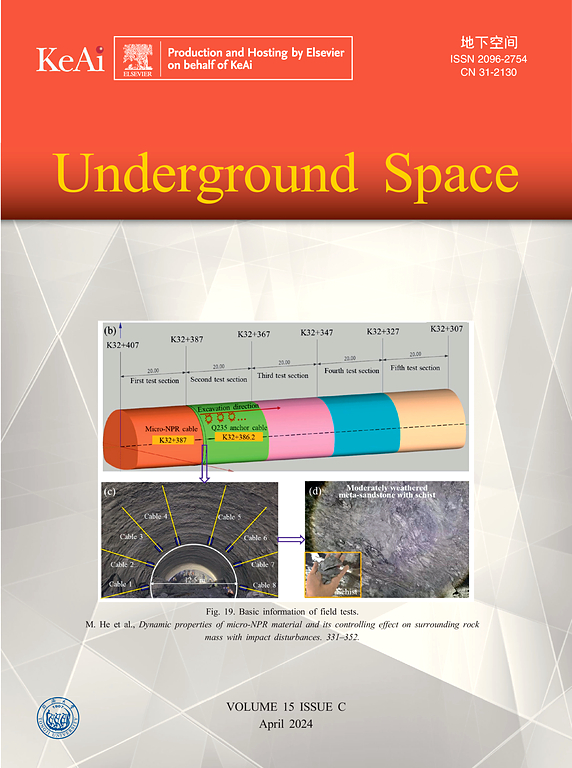城市软土地基隧道人工智能优化盾构参数——以曼谷捷运蓝线为例
IF 8.3
1区 工程技术
Q1 ENGINEERING, CIVIL
引用次数: 0
摘要
以曼谷捷运蓝线为例,对城市软土地基隧道掘进机盾构施工参数的多目标优化(MOO)进行了研究。该研究旨在确定SOPs的最佳组合,包括工作面压力(Fp)、推力(Tf)、注浆压力(Gp)和注浆填充率(Gf),以及相关环境因素,包括隧道深度(Td)、倒排地下水位(Wi)和周围土壤类型(Ts)。从成本考虑,主要目标是提高钻速(按平均值计算),同时从安全性(可使用性)考虑,减少地面沉降(S)。采用长短期记忆(LSTM)神经网络作为预测模型,基于验证数据集的P和S预测模型的产率决定系数(R2)分别为0.81和0.96,均方根误差(RMSE)分别为5.91 mm/min和3.09 mm,平均偏差因子分别为0.99和0.88。该集成框架将非支配排序遗传算法(NSGA-II)与LSTM神经网络相结合,应用于MOO来识别最优sop,同时考虑其作为超过11个时间步长的时间序列对S变化的影响,如本研究所考虑的那样。为了简化和实际的现场实施,在优化过程中,在所有11个时间步中应用相同的一组SOP值。使用该优化框架,当使用简化方法将MOO作为时间序列进行时,最优结果显示Pavg提高了109.8%(从13.99到29.35 mm), S降低了79.6%(从34.55到7.06 mm)。这一发现为有效解决类似软土地基工程中相关因素的时序不确定性提供了有价值的方法。本文章由计算机程序翻译,如有差异,请以英文原文为准。
Artificial intelligence-optimized shield parameters for soft ground tunneling in urban environment: A case study of Bangkok MRT Blue Line
This paper presents a study on multi-objective optimization (MOO) of shield operational parameters (SOPs) for soft ground tunneling using a tunnel boring machine (TBM) in an urban environment, focusing on the case study of the MRT Blue Line in Bangkok. The investigation aims to determine the optimal combination of SOPs, consisting of face pressure (), thrust force (), grout pressure (), and percent grout filling (), along with relevant environmental factors, including tunnel depth (), inverted groundwater level (), and type of surrounding soil (). The primary objective is to enhance the penetration rate (, in terms of average value), as cost consideration, while mitigating ground surface settlement (), as safety (serviceability) consideration. Using long short-term memory (LSTM) neural networks as predictive models, the results yield coefficient of determination (R2) values of 0.81 and 0.96, root mean square error (RMSE) values of 5.91 mm/min and 3.09 mm, and average bias factor values of 0.99 and 0.88 for the and predictive models, respectively, based on validation datasets. This integrated framework, which combines the non-dominated sorting genetic algorithm (NSGA-II) with LSTM neural networks, is applied to MOO to identify the optimal SOPs, while accounting for their influence on variation as a time-series over 11 timesteps, as considered in this study. For simplification and practical field implementation, the same set of SOP values is applied across all 11 timesteps during the optimization process. Using the proposed optimization framework, the optimal results demonstrate improvements in , increasing by up to 109.8% (from 13.99 to 29.35 mm) and in , reducing up to 79.6% (from 34.55 to 7.06 mm) when MOO is conducted as a time series using the simplified method. This finding provides a valuable approach to effectively address the sequential uncertainties of relevant factors in soft ground tunneling for similar projects.
求助全文
通过发布文献求助,成功后即可免费获取论文全文。
去求助
来源期刊

Underground Space
ENGINEERING, CIVIL-
CiteScore
10.20
自引率
14.10%
发文量
71
审稿时长
63 days
期刊介绍:
Underground Space is an open access international journal without article processing charges (APC) committed to serving as a scientific forum for researchers and practitioners in the field of underground engineering. The journal welcomes manuscripts that deal with original theories, methods, technologies, and important applications throughout the life-cycle of underground projects, including planning, design, operation and maintenance, disaster prevention, and demolition. The journal is particularly interested in manuscripts related to the latest development of smart underground engineering from the perspectives of resilience, resources saving, environmental friendliness, humanity, and artificial intelligence. The manuscripts are expected to have significant innovation and potential impact in the field of underground engineering, and should have clear association with or application in underground projects.
 求助内容:
求助内容: 应助结果提醒方式:
应助结果提醒方式:


